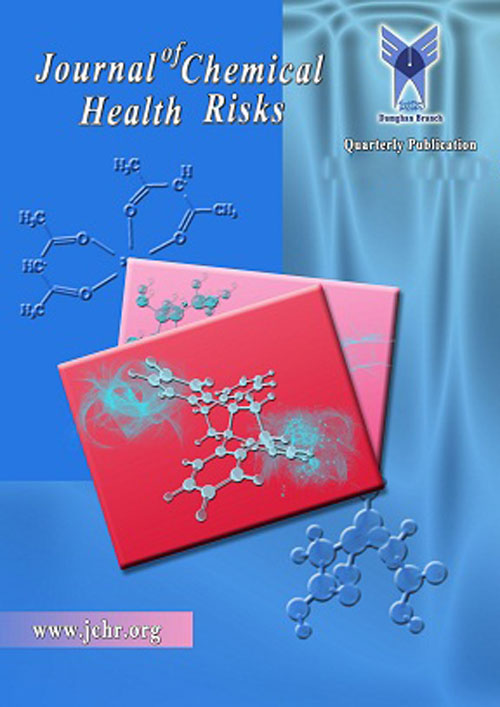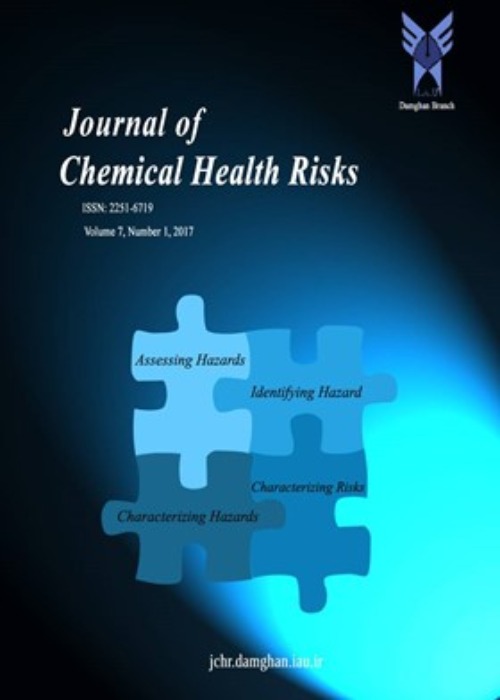فهرست مطالب

Journal of Chemical Health Risks
Volume:5 Issue: 4, Autumn 2015
- تاریخ انتشار: 1394/06/29
- تعداد عناوین: 8
-
-
Page 245This study was aimed to investigate the effects of environmental pollution with heavy metals from ferro-nickel smelter on Aminolevulinic Acid Dehydratase (ALAD) activity, and to analyze the blood lead level of feral pigeon (Columba livia) in ferro-nickel smelter courtyard in Drenas City, Republic of Kosovo. For this purpose, twenty specimens of feral pigeon (20 birds, males and females), were collected in Drenas city which were living in ferro-nickel smelter courtyard, and 20 specimens in Lubizhdë village as control group (non-contaminated area). ALAD activity in Drenas group was significantly inhibited (P<0.001), compared with ALAD activity of controls. The blood lead level was significantly increased (P=0.015) compared to control group. Correlation between ALAD and blood lead level in Drenas group was negative (r=-0.117; P>0.050) and positive in Lubizhdë group (r=0.452; P> 0.050), but not in significant difference between the input groups. Feral pigeons can play an important role as bioindicators, which can used to monitor the environmental pollution with heavy metals that may originate from Nickel metallurgy.Keywords: Environment Pollutants, Pigeon, Blood, Lead, Aminolevulinic Acid Dehydratase
-
Page 251In the present study, the concentrations of three heavy metals including lead (Pb), zinc (Zn) and arsenic (As) in 72 different honey samples collected from North-Western regions of Iran were investigated using atomic absorption spectroscopy method. All metals were detected in 88.88% of the honey samples. The range of metals contamination in honey samples was 0.01 to 11.09 ppm. Zn was the most abundant metal, with an average concentration of 4.41±2.4 ppm. The mean levels of Pb (0.12 ppm) and Zn (6.84 ppm) in honey samples of East Azerbaijan Province was significantly higher than average level of these metals in honeys from other provinces. Based on the results of this study and compared with recommended daily intakes, the heavy metal content of honey samples was not harm and is unlikely to cause any intoxication following honey consumption.Keywords: Atomic absorption, spectrometry, Honey, Heavy Metals, Iran
-
Page 257An aqueous extract of Pimpinella anisum was used for green synthesis of silver nanoparticles by bio reduction of an aqueous solution of silver nitrate. Silver nanoparticles were characterized by UV–Vis spectrometry, Fourier transform infrared spectroscopy (FTIR), X-ray diffraction (XRD) analysis, scanning electron microscopy (SEM) and energy-dispersive X-ray analysis (EDAX). The increase in absorption at 420 nm was used for recording the formation of a colloidal suspension of silver nanoparticles. The binding properties of the capped Ag nanoparticles synthesized from aqueous extract of P. anisum were analyzed by FTIR. XRD studies revealed that most of the nanoparticles were cubic and face centered cubic in shape. SEM analysis showed the size and shape of silver nanoparticles and EDAX confirmed the presence of silver. The synthesized silver nanoparticles showed DPPH free radical scavenging activity.Keywords: Pimpinella anisum L., Green synthesis, Silver nanoparticles, Crystalline, SEM, XRD
-
Page 267Florfenicol is a broad-spectrum antibiotic, widely used in veterinary medicine. The aim of this study was to determine florfenicol residues in the muscle and liver of cultured rainbow trout in Iran by ELISA. The samples were collected from three areas (Kiar, Ardal, and Koohrang), considered as areas with high production of trout in the western part of Iran. Sampling was completed during the spring and summer of 2011. All of the samples were categorized into three weight groups (below 50g, 50 to150g and over 150g) and five individuals were randomly selected from fish belonged to each weigh group, and then collected samples sent for determination of antibiotic residues. The highest and the lowest antibiotic residues were 31.42±53.52 ng g-1 (>150 g fish) and 10.35±2.33 ng g-1 (<50 g fish) for liver samples and 48.84±50.36 ng g-1 (50-150 g fish) and 18.20±15.41 ng g-1 (> 150 g fish) for muscle samples, respectively. In different areas, the highest antibiotic levels were found in Koohrang and Ardal with mean of 37.00±63.61 and 15.33±10.45 ng g-1 for liver samples and 40.74±40.80 and 28.24±45.91ng g-1 for muscle samples. The results indicated that florfenicol residues are lower than the maximum permissible level has been announced by the European Union.Keywords: Florfenicol, ELISA, Liver, Muscle, Rainbow trout
-
Page 273Environmental stresses are one of the most important factors of agricultural products reduction in the world. The influence of different concentrations of nickel nitrate (0, 100, 200 and 500 μM in Hoagland’s solution) on dry matter, catalase enzyme, flavonoids, hydrogen peroxide, peroxidase Enzyme, MDA and accumulation of Ni were studied in coriander (Coriandrum sativum) plants. Treatment with Ni led to significant increase in flavonoids, hydrogen peroxide, MDA and other aldehyde. Exposure of coriander plant to Ni altered catalase enzymes, leading to significant decrease in their contents. In both shoots and roots of coriander plants, significant decrease in dry matter was observed. Ni accumulation increased significantly in shoots and roots. Ni increased in the roots more than the shoots. According to a more accumulation of Ni in the roots, the expansion of plants root can help to better adaptability with the toxicity of metals. It may be used as an indicator to illustrate the differences between plant species.Keywords: Coriander, Hydroponics, Heavy metal, Nickel nitrate
-
Page 285In this study, the effects of different concentrations of bulk and nano-sized Ag on seed germination and seedling growth of canola were investigated in a randomized completely design with four replications. The experimental treatments included four concentrations of bulk AgNO3 (10, 100, 500 and 1000 ppm), four concentrations of nanosized Ag (10, 100, 500 and 1000 ppm), and the control without Ag. Results indicated that among the canola germination indices only mean germination time and germination index were not affected by treatments. The TTC tests showed all root tips were colored red. It is concluded that bulk AgNO3 treatments inhibited germination indices of canola more than nano sized Ag.Keywords: Canola, Ag nanoparticles, Bulk AgNO3, Germination indices, Seedling Biomass, Seedling length
-
Page 295Recent studies show that synthetic glucocorticoids alter testicular homeostasis, In this regard, the influence of Betamethasone as a glucocorticoid widely used on histological changes, epididymal sperm counts and fertility was explored in male mice. The study sample (50 mice) was allocated to 3 treatment groups, placebo and a control group. Control group was no injected. Only normal saline was given to the placebo group and Betamethasone (0.1, 0.5 and 1 mg/kg) was injected to the treatment group in peritoneum for 20 days (every other day). After treatment periods, two mice from each group were selected to measure fertility and each male with two females mice were kept for 15 days. After two weeks, the female mice were sedated and the number of embryos in the uterine horn was counted. However, epididymal sperm was counted in others mice by preparation epididymal suspension. The data analysis was done in SPSS through the Duncan''s multiple ranges test. Evaluation of epididymal sections under the microscope showed difference between the group treated in epididymal tissue sections and the control group. This means that the amount of spermatozoa in treated groups with Betamethasone was lower than in the control group. Epididymal sperm and the fertility rate in all doses of Betamethasone significantly decreased compared with the control group. However, increasing the dose of Betamethasone fertility rate also non-significantly decreased. It seems that glucocorticoids like the Betamethasone affect testicular function and spermatogenesis Causes reduced fertility and have adverse effects on male reproduction.Keywords: Betamethasone, Epididymal sperm, Fertility, Mice
-
Page 301The contamination of cereals with toxic secondary metabolites of fungi, mycotoxins, is a permanent challenge in human health. These toxins are produced by a few fungi are mainly of the genera Fusarium, Aspergillus and Penicillium. Ochratoxin A is a nephrotoxic mycotoxin, which possesses carcinogenic, teratogenic, immunotoxic and possibly neurotoxic properties. Zearalenone is a non-steroidal estrogenic toxin, which has been involved in incidents of precocious pubertal changes. In this study, we reviewed recent researches in zearalenone and ochratoxin A contamination in cereals and cereal based productsKeywords: Zearalenone, Cereals, Ochratoxin A, Mycotoxin


